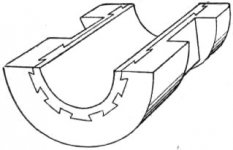dcstang1967
Aluminum
- Joined
- Feb 24, 2014
My machine did not have the proper spindle bearings in it when i bought it a few years ago. I got it dialed in pretty good, but i want it to be correct. The previous owner made a bearing housing that holds an automotive type tapered bearing for the left side which is not nearly precise.

The right side bearing looks like an original that has been babbited, but is no longer round and the babbit is coming loose from the bronze shell.

I spent a good amount of time measuring and documenting everything when the machine was all apart. The spindle bearing journals are in perfect shape.
I bought my bronze stock from Bravobronze.com. They sell all different kinds of bronze in any shape and size. I ordered a couple cored lengths to minimize my rough machining. The alloy i chose was C932 which is SAE 660 bearing bronze. They sell it by the inch so i ordered enough to hold in the chuck as well. I got 5" of 3" diameter for the right side and 6" of 2.25" diameter for the left side. Total with shipping was $104.
I chucked up the large piece in my 4 jaw and indicated it in and out until i was happy and took a couple cleaning cuts on the OD. Then i started my rough boring.

I bored it until i was at .005" under my goal and will do the finish bore as my last process before i part it off.
I started roughing in the recess on the OD for the headstock journal.


The right side bearing looks like an original that has been babbited, but is no longer round and the babbit is coming loose from the bronze shell.

I spent a good amount of time measuring and documenting everything when the machine was all apart. The spindle bearing journals are in perfect shape.
I bought my bronze stock from Bravobronze.com. They sell all different kinds of bronze in any shape and size. I ordered a couple cored lengths to minimize my rough machining. The alloy i chose was C932 which is SAE 660 bearing bronze. They sell it by the inch so i ordered enough to hold in the chuck as well. I got 5" of 3" diameter for the right side and 6" of 2.25" diameter for the left side. Total with shipping was $104.
I chucked up the large piece in my 4 jaw and indicated it in and out until i was happy and took a couple cleaning cuts on the OD. Then i started my rough boring.

I bored it until i was at .005" under my goal and will do the finish bore as my last process before i part it off.
I started roughing in the recess on the OD for the headstock journal.














